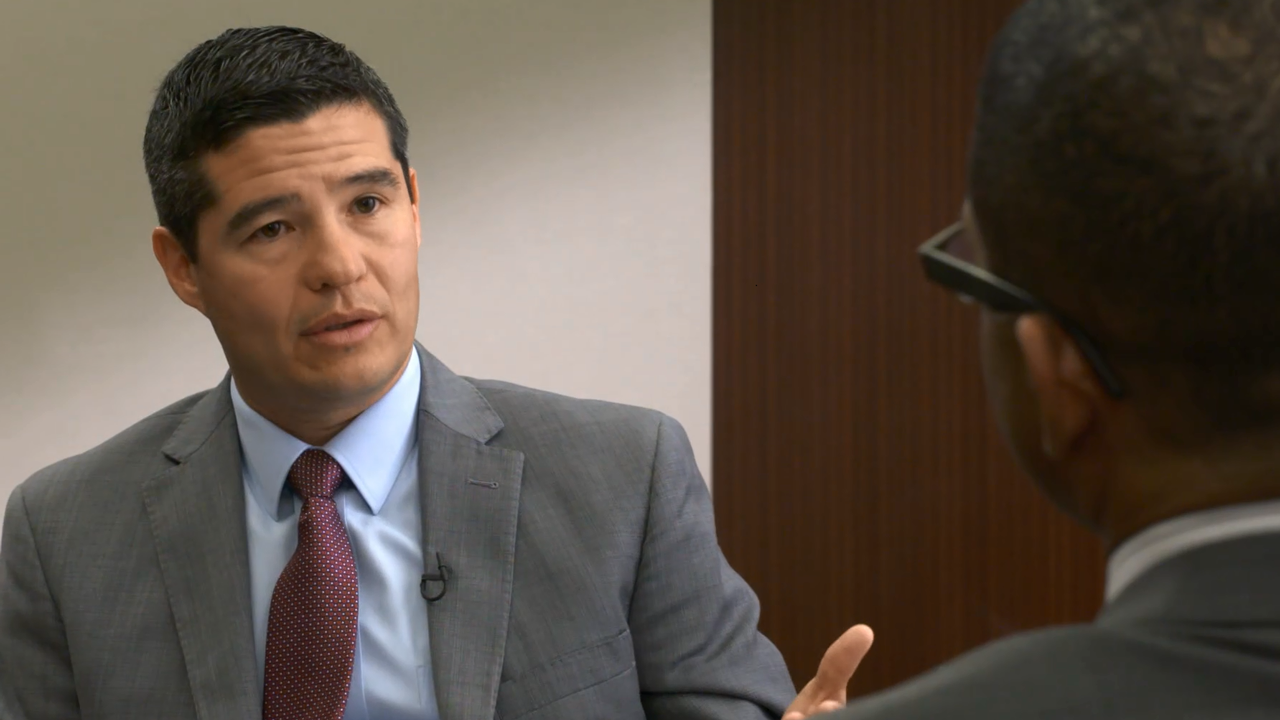Primary Endpoint of the PLATINUM Diversity Trial
Presented at TCT 2016

Dr. Batchelor Explains the Importance of Studying Under-represented Patient Populations.
Juan: It is my pleasure to be here before TCT talking to a colleague of mine, a very good interventional cardiologist, well known, Wayne Batchelor. Good afternoon.
Wayne: Good afternoon, Juan.
Juan: Why don't you just start by introducing yourself and telling us about your institution?
Wayne: Sure. I'm an interventional cardiologist in Tallahassee, Florida. I'm a member of the Southern Medical Group there, and I'm the Clinical Council Co-chair for the Interventional Program at Tallahassee Memorial Hospital.
Juan: Okay. The reason why you're here this afternoon is because we are going to discuss very interesting study that will be presented as a first report investigation at TCT and is the PLATINUM Diversity study. Why don't you just tell me- we've been talking about this for quite some time. The diverse population of the US, how demographics are changing in the US and Europe and globally, and are the studies that we present every year in TCT representative of what happened in the real world? How did you guys get together, come up with this idea, we need to do this, and why this study is conceptually important?
Wayne: Many clinicians and investigators have recognized that there's been a paucity of data in minorities and women undergoing percutaneous coronary interventions and in general in cardiovascular medical research. This has been recognized for actually decades. The FDA has put forth policies and guidelines and so has the NIH to try to impact this paucity of data and this gap in knowledge. Interestingly, it hasn't had a huge impact. When you look at the diversity of the US population and the increasing diversity, by 2050 more than 50% of our population is going to be people of color. Right now about a third are people of color.
Whereas when you look at clinical trials and the enrollment of clinical trials, right now, the vast majority, 85 to 90% of clinical trial participants in most cardiovascular research trials are Caucasian and women constitute maybe about 25% of most of these studies.
Juan: Explain to me why that happens. It's actually a selection bias, is actually access that patients have to the hospital, is actually a research bias? Why that happens?
Wayne: Very complicated question, but probably all of the above. Studies have shown that you're less likely to be asked to participate in research if you're a minority. You're a little bit less likely to say yes. The way in which you're asked matters.
Juan: Language barriers, cultural barriers.
Wayne: Cultural barriers, language.
Juan: To be afraid of being lost in follow-up.
Wayne: Yes. Even the fact that the hospital that you arrive at if you're a minority may be different and you're less likely to have well-developed research in some of these hospitals in the inner cities and other places that are spending time looking after patients and may not have well-developed research programs. There are a host of issues that relate to the clinician who looks after the patient, the patient, the environment, the hospital, and then some other inception biases that have been present for years.

What was the Study Design for PLATINUM Diversity?
Juan: Study design. Tell us overall the study design, how design was constructed and the assumptions behind studies and so forth.
Wayne: The study of sponsor Boston Scientific and the study committee, the organizing committee, spent a lot of time on this. We thought what were the key parameters that we'd want to collect prospectively in order to understand some of these dynamics? First of all, we thought that using an enriched cohort approach would be the way to go so that we intentionally just enrolled women and minorities to collect a high number of women and minorities in the study design quickly. Then we were going to compare those outcomes to Caucasian males or white males that we had already from the PROMUS Element Post-Approval Study that's already been published in the American Journal of Cardiology. Dr. Kandzari was the first author on that paper.
We have a lot of information already from post-market approval studies on the performance of everolimus-eluting stents. We just didn't have enough for minorities. We used this sort of enriched enrollment design to collect more information on the minorities. We also talked about what was important to collect. Instead of collecting a lot of pedantic detail about specific angiographic lesions, we tried to collect basic angiographic information, but more importantly, collect a lot more socioeconomic data. We have a lot of information on these patients regarding their educational status, income, employment, access to healthcare, language, concordance between the patient and the physician, and many other factors that are more social factors that might govern outcome.

View Dr. Batchelor Share the Primary Endpoint Results of the PLATINUM Diversity Trial.
Juan: I'm fascinated by this study because I travel lot to do first in human side of the US, and I'm always amazed at how different healthcare is in different countries. How for example financial incentives, how for example, the capability to pay for pharmacological support really impacts the outcome of patients. Cath labs operate with no [inaudible 00:05:35]. Some of the patients actually cannot afford Plavix for 12 months. I really think the impact that these socioeconomical differences make in patients' outcomes are profound. Tell us about the outcomes, oral outcomes of the study and number of patients in the groups and so forth.
Wayne: First of all, at this time, we have only the primary outcome and secondary outcome analyses. The socioeconomic analyses will follow, and I think that's going to be, perhaps, some of the most interesting, intriguing data. I think you hit the nail on the head. There's a lot to learn from how socioeconomic factors can impact outcome, and we've seen that in the past. We're looking forward to studying that in the future in the platinum diversity study.
As of today, we have outcomes for the primary endpoint, which in this case was death, myocardial infarction, and target vessel revascularization and the secondary endpoints of death, myocardial infarction as independent outcomes and then the composite of death and myocardial infarction. Basically, the study showed, first of all, we enrolled a little over 1000 minorities, 1057 minorities. There were a little over 1800 women and a little over 1600 white men enrolled in the study by combing the PLATINUM Diversity enrollment with the PROMUS Element Post-Approval Study. We had good numbers of patients, first of all, to study, a very good sample size.
We have over 80% statistical power to detect a 3% difference in the composite endpoint of death, myocardial infarction, and target vessel revascularization. We found that for death, MI, and TVR, there were no statistically significant differences between the three groups, although numerically, there was a trend. In white men, the TVR rate was 7.9%, sorry 7.6% and it was 8.6 and 9.6% in the women and minorities. When you looked at TVR as a standalone endpoint, there was absolutely no difference between the three groups. However, the secondary endpoint of death for minorities and death and MI for both minorities and women was encountered more frequently in women and minorities compared with white males.
Juan: It's fascinating because likely, this is non-TLR events, right?
Wayne: These are non-TLR events, and what's quite interesting is the stent-related outcomes, things like TVR and stent thrombosis were statistically no different between any of the groups, but when you looked at the hazard for myocardial infarction at one year, it was significantly higher for minorities and for women in the study, even after you adjusted as best as we could for all the imbalances and baseline characteristics. I should know that imbalances were there in the baseline characteristics. Women tended to be a little older and both the minorities and the women tended to have higher instance of heart failure, renal disease, hypertension.
There were some inter-graphic differences whereas they tended to have more calcification and tortuosity and a slightly higher rate of chronic total occlusions, whereas white men tended to present with a higher rate of ACS and thrombosis and were slightly younger than women, as you might expect. There were some innate differences in the way that patients came to the cath lab. The question in this study is did we adequately account for those? We did include all of these factors in the statistical model and still had a very strong P-value for myocardial infarction and for both minorities compared to white men and women compared to white men. However, it remains to be seen as to whether or not we fully accounted for all those differences.

What are the Future Implications of these Results?
Juan: Let's break the discussion into two. Women first. What do you think the difference is? Just hypothesis generation. We have talked for quite some time about biological differences, about estrogen influence and biological makeup. What is your sense here? Women actually have worse outcomes because they get disease that is more aggressive, the risk profile is different. Are we perhaps intervening in women later than we should? What do you think?
Wayne: Well, it's difficult to tease through this this with a great deal of accuracy, to be honest with you. I think my opinion is that some of the risk factors that come to bear are significantly different, and I'm not sure that we fully could account for all those differences. They definitely are older. They definitely have more heart failure, more hypertension, they have more tortuosity and calcification. The lesions may be more difficult. The reference vessel diameter is a little bit smaller. All these parameters may play a role in outcome.
Now, the socioeconomic and other behavioral and social data, we still have yet to analyze, so there may be something in that as well. Obviously, the hormonal mileau is also something that people hypothesize as to potentially impacting outcomes. I think what will help us with PLATINUM Diversity is we will actually have the backdrop to study this a little bit better, especially the socioeconomic factors, and I really look forward to seeing how that analysis comes out.
Juan: Now, minorities. One piece of data that I was really shocked about is in one of the slides it was described that the percentage of PCIs that are actually done in minorities on regular basis is actually quite shocking, especially if you look at the census of the demographics that we have in the US and we're going to have by 2050. What is happening with those patients? I mean, are we neglecting care to those patients or patients having MIs in their houses and not really going to the physician? It's actually shocking to me was more of a public health concern when I saw the numbers.
Wayne: There's been a long legacy of a difference in the number of PCI procedures done across different racial groups as well as bypass procedures done. There's always been a lower rate of utilization seen in minorities. There's a longstanding history of this. The reason for that is obviously up to debate, but almost everywhere along the line, there are probably impediments. I think some of these socioeconomic factors and access to healthcare may play a role. I think that decisions, whether we like it or not, there are some biases that are intrinsic to the healthcare system, perhaps the provider and even the patient. Patient decision making plays a role in this as well. I think these are complex questions that beg further study, but I have a feeling it's not going to drill down to just one particular factor.
Juan: What do you think is going to happen when people see this data and how can this change practice and the behavior of the interventionalist in daily practice?
Wayne: I think, number one, it's going to provide some heightened awareness as to these differences. It'll force us to explore the questions as to why, both from the clinical factors as well as some of the non-clinical or perhaps social factors and socioeconomic factors, access to healthcare factors. Furthermore, I think it's going to push us into another era, I hope, where we're not going to be just doing all-comers studies all the time. That has failed us for decades. When you do an all-comers study, it's not a random selection. It's a very selected and biased sample of patients that's not reflective of the United States population and our community at large.
I think this kind of diversity enriched cohort study actually has value, and it can supplement some of the standard all-comers studies that we do. For example, if you're going for an IDE, an investigational device exemption, you have to do an all-comers study and get a broad sweep of patients as best as you can. If one sees that there's paucity of data relative to particular sub-population, whether it's women, minorities, or anything else, for that matter, I think this concept of supplementing the data by doing phase four of post-market surveillance on particular groups, you can do that, and we show that you can do it rapidly, effectively, and with the right study design come up with some very interesting observations.
Juan: Listen, from the governmental point of view, I think the impact is profound. It's really alarming to think that a big percentage of minority population is not being in a way properly intervened in a critical condition. Imagine these patients later on having heart failures. Multiple re-hospitalization, and expenditures actually go through the roof, so I really think that this piece of data is extremely important for the people that are paying attention to health economics and the impact of providing good healthcare to the entire population this country.
Wayne: I couldn't agree with you more, Juan, and it's interesting that 2016 has been declared the year of diversity in clinical trials by our FDA commissioner Rob Califf. I think it's timely that this study came out in 2016, and I'm hoping that it'll be a springboard for the research in this arena.
Juan: Listen, congratulations. It was actually for me refreshing to see something different at TCT. It's an extremely interesting piece of data, and the most important thing is the impact that this can have in society and in our daily practices. Thank you for the idea, for conducting the trial with your group, and to all the co-PIs and investigators. A great piece of data. Congratulations.
Wayne: Thank you.
Close the Gap is Boston Scientific's health equity initiative, which aims to eliminate cardiovascular care disparities. Learn more
















